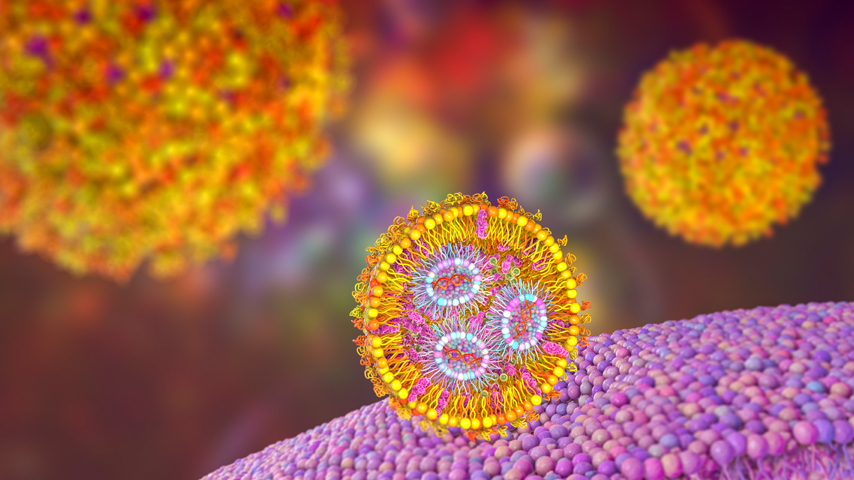5 Ways Nanotech Affects Everyday Life
5 Ways Nanotech Affects Everyday Life


Nanoparticles are used in a slew of products, thanks to their small size, carrier abilities, and dispersal properties.
In April 2023, hygiene brand Dove introduced a “Renewing MicroMoisture” body wash that will moisturize skin with the help of millions of tiny, dispersed droplets—something that’s made possible through the use of nanotechnology.
Nanoparticles are prevalent in many everyday products from makeup to food packaging and even in the way we absorb medicines. The extremely small size of nanoparticles opens a slew of potential uses. For comparison, a nanoparticle is 100 nanometers wide, a single nanometer is 1/1,000 of a micrometer, and a human hair is anywhere from 50 to 100 micrometers wide. The high surface area of nanoparticles makes them suitable as catalysts and many nanomaterials exhibit markedly more desirable properties such as strength and conductivity than their larger-sized equivalents.
While scientists can come up with a variety of uses for particles that are that small, they still need to be studied and manipulated at the nanometer level to ensure that the materials are performing as designed.
Here are five ways in which nanotechnology touches our everyday lives.
Similar Reading: New Nanomaterial Proves Stronger Than Kevlar
Research into nanoparticles has demonstrated that this problem can be addressed by having therapeutic drugs piggyback on nanoparticles attached to RNA strands. The RNA strands are attracted to cancer cells and when the RNA attaches to these cells, cancer-fighting drugs are offloaded, leading to more targeted delivery. Nano-carriers also help in therapies to fight diabetes to ensure that drug delivery occurs without interference and that medicine is released according to a fixed schedule.
Advanced mechanisms to constantly monitor blood glucose levels with wearable sensors also makes use of nanotechnology to detect gradual variations in the chemical composition of sweat. Sending patients home with such monitoring devices that can transmit health data remotely to medical professionals enables hospitals to shorten stays and still monitor patients in need.
Become A Member: How to Join ASME
The targeted delivery mechanisms that nanoparticles execute so well in drug deliveries can be translated to moving vitamins within the body and even targeted pesticide applications in farming crops.
You Might Also Enjoy: A 3D Nano Ink for Stronger, Lighter Builds
As widely used as nanoparticles already are, they’re not without controversy. Debate continues about their environmental and health impacts, and their use often needs to pass through regulatory mechanisms.
From healthcare monitoring through medical patches to use in paints and computers, nanoparticles can improve everyday processes in a variety of ways. Expect nanoparticles to become even more ubiquitous in a variety of areas in the future. As the market for wearables increases, for example, so does the imperative to monitor health vitals, and nanoparticles will likely integrate into more advanced sensors. Their small size, ability to act as effective carriers, and dispersal properties are why nanoparticles continue to find new applications in a variety of industries.
Poornima Apte is a technology writer in Walpole, Mass.

Nanoparticles are prevalent in many everyday products from makeup to food packaging and even in the way we absorb medicines. The extremely small size of nanoparticles opens a slew of potential uses. For comparison, a nanoparticle is 100 nanometers wide, a single nanometer is 1/1,000 of a micrometer, and a human hair is anywhere from 50 to 100 micrometers wide. The high surface area of nanoparticles makes them suitable as catalysts and many nanomaterials exhibit markedly more desirable properties such as strength and conductivity than their larger-sized equivalents.
While scientists can come up with a variety of uses for particles that are that small, they still need to be studied and manipulated at the nanometer level to ensure that the materials are performing as designed.
Here are five ways in which nanotechnology touches our everyday lives.
1. Vaccines
Nanoparticles are the size of viruses and are being used and tested in the fight against COVID-19 in many ways. Principal among these is the use of lipid nanoparticles that coat the primary components so that the vaccine can do its job without being attacked on its way. The lipid or polymeric nanoparticles in this case act as a carrier vehicle to deliver the mRNA to cells and stimulate them to produce antibodies against the virus. In the future, nanomaterial patches that don’t require refrigeration could be used as the dispensing mechanism for COVID-19 vaccines.2. Disease-fighting
Traditional chemotherapy-based cancer treatments have usually involved a spray-and-pray approach, targeting tumors with cancer-fighting drugs. Unfortunately, healthy cells in the neighborhood become collateral damage as the delivery of the medicines is not as precise down to the cellular level.Similar Reading: New Nanomaterial Proves Stronger Than Kevlar
Research into nanoparticles has demonstrated that this problem can be addressed by having therapeutic drugs piggyback on nanoparticles attached to RNA strands. The RNA strands are attracted to cancer cells and when the RNA attaches to these cells, cancer-fighting drugs are offloaded, leading to more targeted delivery. Nano-carriers also help in therapies to fight diabetes to ensure that drug delivery occurs without interference and that medicine is released according to a fixed schedule.
Advanced mechanisms to constantly monitor blood glucose levels with wearable sensors also makes use of nanotechnology to detect gradual variations in the chemical composition of sweat. Sending patients home with such monitoring devices that can transmit health data remotely to medical professionals enables hospitals to shorten stays and still monitor patients in need.
3. Food
Silver nanoparticles embedded in plastic kill bacteria from stray food particles while nanoparticles in bottle manufacturing composition can help prevent carbon dioxide leaks and keep carbonated drinks fresh. Nanoparticles can also help by enabling more flavor delivery for less weight. Salt, for example, might deliver a more potent flavor profile at the nanoscale, potentially enabling less consumption for similar taste.Become A Member: How to Join ASME
The targeted delivery mechanisms that nanoparticles execute so well in drug deliveries can be translated to moving vitamins within the body and even targeted pesticide applications in farming crops.
4. Cosmetics
Nanoparticles’ attributes make them especially popular in a wide range of skincare products from anti-aging creams to makeup formulations. Manufacturers are able to create cosmetics that blanket the skin more thoroughly and evenly by uniformly dispersing nanoparticles. For example, nanoparticles of titanium dioxide and zinc oxide are commonly found ingredients in sunscreen because they disperse well and block harmful rays. Even dispersal also helps in creating a smooth appearance upon application.5. Clothing
Clothes that are moisture-wicking or offer sun protection are usually the result of adding nanoparticle layers to fabric. Manufacturers use nanotechnology to make clothes wrinkle-resistant and water-repellent. Antimicrobial zinc oxide or silver nanoparticles help cut odor-causing bacteria and help with odor control in clothes. A coating of nanoparticles on clothes can also improve stain resistance.You Might Also Enjoy: A 3D Nano Ink for Stronger, Lighter Builds
As widely used as nanoparticles already are, they’re not without controversy. Debate continues about their environmental and health impacts, and their use often needs to pass through regulatory mechanisms.
From healthcare monitoring through medical patches to use in paints and computers, nanoparticles can improve everyday processes in a variety of ways. Expect nanoparticles to become even more ubiquitous in a variety of areas in the future. As the market for wearables increases, for example, so does the imperative to monitor health vitals, and nanoparticles will likely integrate into more advanced sensors. Their small size, ability to act as effective carriers, and dispersal properties are why nanoparticles continue to find new applications in a variety of industries.
Poornima Apte is a technology writer in Walpole, Mass.

Pulse of the Profession: CAD in 2030
CAD technologies and their applications have been steadily evolving ever since, ushering in a bevy of new techniques and approaches over the decades.






